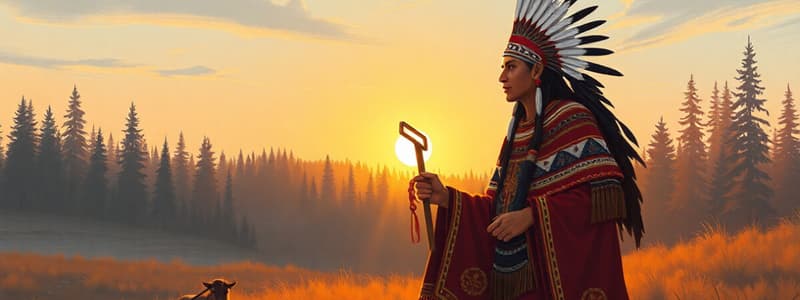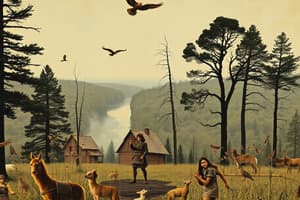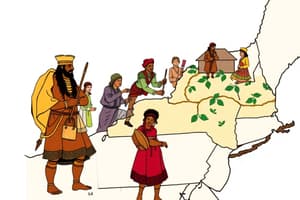Podcast
Questions and Answers
What was the primary goal of the confederacy?
What was the primary goal of the confederacy?
- To eliminate all spiritual beliefs
- To keep peace among themselves and unite against enemies (correct)
- To create a singular ruling chief for all nations
- To conquer neighboring tribes
What role did sachems play in the confederacy?
What role did sachems play in the confederacy?
- They were responsible for training priests
- They acted as warriors in times of conflict
- They were spiritual leaders only
- They served as members of the League Council and led their nations (correct)
What is the Grand Medicine Society associated with?
What is the Grand Medicine Society associated with?
- A religious society among the Ojibwe (correct)
- A philosophical guide for all nations
- A council of warriors
- A form of governance
Which of the following is NOT one of the seven teachings valued by the Ojibwe?
Which of the following is NOT one of the seven teachings valued by the Ojibwe?
How did the confederacy influence the United States Constitution?
How did the confederacy influence the United States Constitution?
What is the seventh generation principle?
What is the seventh generation principle?
Which characteristic is attributed to the governance of the confederacy?
Which characteristic is attributed to the governance of the confederacy?
What belief does animism encompass as held by many Northeast nations?
What belief does animism encompass as held by many Northeast nations?
What material was primarily used for constructing the walls of wigwams?
What material was primarily used for constructing the walls of wigwams?
What were the primary resources provided by the Eastern Woodlands for the people living there?
What were the primary resources provided by the Eastern Woodlands for the people living there?
Which language groups were the peoples of the Northeast primarily categorized into?
Which language groups were the peoples of the Northeast primarily categorized into?
How many families typically lived in a longhouse?
How many families typically lived in a longhouse?
Which group spoke the Iroquoian languages in the Northeast?
Which group spoke the Iroquoian languages in the Northeast?
What did the term 'dodems' refer to in the Ojibwe nation?
What did the term 'dodems' refer to in the Ojibwe nation?
What type of landscape primarily characterized the Northeast region during the time of its original peoples?
What type of landscape primarily characterized the Northeast region during the time of its original peoples?
Which of the following clans were considered leaders in the Ojibwe clan system?
Which of the following clans were considered leaders in the Ojibwe clan system?
What type of food sources were available to the peoples of the Eastern Woodlands?
What type of food sources were available to the peoples of the Eastern Woodlands?
What was a primary function of the holes in the roofs of both wigwams and longhouses?
What was a primary function of the holes in the roofs of both wigwams and longhouses?
Where did most people in the Northeast region choose to live?
Where did most people in the Northeast region choose to live?
Which clan structure was primarily centered around the mother's family?
Which clan structure was primarily centered around the mother's family?
Which animal was commonly hunted by the peoples of the Northeast for food and fur?
Which animal was commonly hunted by the peoples of the Northeast for food and fur?
What distinguished a longhouse from a wigwam in terms of structure?
What distinguished a longhouse from a wigwam in terms of structure?
Which of the following statements regarding clan behavior is true?
Which of the following statements regarding clan behavior is true?
What was one of the key features of the culture in the Northeast region by 1500 CE?
What was one of the key features of the culture in the Northeast region by 1500 CE?
What does the principle mentioned in the content emphasize regarding responsibility?
What does the principle mentioned in the content emphasize regarding responsibility?
Which festival is celebrated by the Haudenosaunee nations during the midwinter?
Which festival is celebrated by the Haudenosaunee nations during the midwinter?
What is wampum primarily made from?
What is wampum primarily made from?
How did art integrate into the daily lives of Northeast nations?
How did art integrate into the daily lives of Northeast nations?
Which of the following were common styles of clothing worn by people in the Northeast?
Which of the following were common styles of clothing worn by people in the Northeast?
What significant item did men specifically wear, which indicated their nation?
What significant item did men specifically wear, which indicated their nation?
What was the role of wampum beads during meetings among the Northeast nations?
What was the role of wampum beads during meetings among the Northeast nations?
What decorative elements were commonly used on clothing by people of the Northeast?
What decorative elements were commonly used on clothing by people of the Northeast?
What distinguished the Ojibwe people's seasonal living pattern from other nations?
What distinguished the Ojibwe people's seasonal living pattern from other nations?
What does the name 'Mahican' mean?
What does the name 'Mahican' mean?
What was the primary aim of Hiawatha and Deganawida in creating the Haudenosaunee Confederacy?
What was the primary aim of Hiawatha and Deganawida in creating the Haudenosaunee Confederacy?
Which groups were part of the Haudenosaunee Confederacy?
Which groups were part of the Haudenosaunee Confederacy?
Why did Hiawatha wander in the wilderness?
Why did Hiawatha wander in the wilderness?
Where did the Mahican people eventually settle?
Where did the Mahican people eventually settle?
What was a significant feature of Haudenosaunee villages?
What was a significant feature of Haudenosaunee villages?
Which group was known as the Mahican's most bitter enemy?
Which group was known as the Mahican's most bitter enemy?
What was the most valuable item traded among the nations of the Eastern Woodlands?
What was the most valuable item traded among the nations of the Eastern Woodlands?
What does the Tree of the Great Peace symbolize in the context of the Five Nations?
What does the Tree of the Great Peace symbolize in the context of the Five Nations?
How did the position of feathers on a gustoweh differ among the nations?
How did the position of feathers on a gustoweh differ among the nations?
What is the significance of the Eagle atop the Tree of the Long Leaves?
What is the significance of the Eagle atop the Tree of the Long Leaves?
What motivated trade among the Eastern Woodlands nations before European arrival?
What motivated trade among the Eastern Woodlands nations before European arrival?
Who is recognized as the initiator of the Tree of Great Peace?
Who is recognized as the initiator of the Tree of Great Peace?
Which direction do the roots of the Tree of Great Peace extend?
Which direction do the roots of the Tree of Great Peace extend?
What conditions must a man or nation meet to be welcomed under the Tree of Long Leaves?
What conditions must a man or nation meet to be welcomed under the Tree of Long Leaves?
Flashcards
Eastern Woodlands
Eastern Woodlands
The region stretching from the Great Lakes to the Atlantic coast, known for its abundant forests and diverse Native American cultures.
Algonquian-speaking Nations
Algonquian-speaking Nations
A group of Native American nations in the Northeast who spoke Algonquian languages, including the Ojibwe.
Iroquoian-speaking Nations
Iroquoian-speaking Nations
A group of Native American nations in the Northeast who spoke Iroquoian languages, including the Haudenosaunee.
Siouan-speaking Nations
Siouan-speaking Nations
Signup and view all the flashcards
Natural Resources of the Eastern Woodlands
Natural Resources of the Eastern Woodlands
Signup and view all the flashcards
Clearing Land
Clearing Land
Signup and view all the flashcards
Northeast Nations
Northeast Nations
Signup and view all the flashcards
Forests
Forests
Signup and view all the flashcards
Longhouse
Longhouse
Signup and view all the flashcards
Wigwam
Wigwam
Signup and view all the flashcards
Matrilineal
Matrilineal
Signup and view all the flashcards
Patrilineal
Patrilineal
Signup and view all the flashcards
Clan
Clan
Signup and view all the flashcards
Dodems
Dodems
Signup and view all the flashcards
Fire pit
Fire pit
Signup and view all the flashcards
Clan way of life
Clan way of life
Signup and view all the flashcards
Ojibwe Seasonal Movement
Ojibwe Seasonal Movement
Signup and view all the flashcards
Mahican Origin Story
Mahican Origin Story
Signup and view all the flashcards
Haudenosaunee Confederacy
Haudenosaunee Confederacy
Signup and view all the flashcards
Haudenosaunee Nations
Haudenosaunee Nations
Signup and view all the flashcards
Haudenosaunee Village Location
Haudenosaunee Village Location
Signup and view all the flashcards
Iroquois Confederacy
Iroquois Confederacy
Signup and view all the flashcards
Mahican-Mohawk Conflict
Mahican-Mohawk Conflict
Signup and view all the flashcards
Haudenosaunee Formation
Haudenosaunee Formation
Signup and view all the flashcards
What was wampum?
What was wampum?
Signup and view all the flashcards
What was wampum used for?
What was wampum used for?
Signup and view all the flashcards
What kind of clothing did Northeastern nations wear?
What kind of clothing did Northeastern nations wear?
Signup and view all the flashcards
What was a gustoweh?
What was a gustoweh?
Signup and view all the flashcards
Confederacy Government
Confederacy Government
Signup and view all the flashcards
Sachem
Sachem
Signup and view all the flashcards
League Council
League Council
Signup and view all the flashcards
Animism
Animism
Signup and view all the flashcards
Grand Medicine Society
Grand Medicine Society
Signup and view all the flashcards
Seven Teachings
Seven Teachings
Signup and view all the flashcards
Seventh Generation Principle
Seventh Generation Principle
Signup and view all the flashcards
Wander in the Wilderness
Wander in the Wilderness
Signup and view all the flashcards
What were gustowehs?
What were gustowehs?
Signup and view all the flashcards
Describe pre-European contact trade in the Eastern Woodlands.
Describe pre-European contact trade in the Eastern Woodlands.
Signup and view all the flashcards
Who were the Haudenosaunee?
Who were the Haudenosaunee?
Signup and view all the flashcards
Explain the meaning of the Great Tree of Peace.
Explain the meaning of the Great Tree of Peace.
Signup and view all the flashcards
What do the Great White Roots represent?
What do the Great White Roots represent?
Signup and view all the flashcards
What is the role of the eagle in the Haudenosaunee Great Law of Peace?
What is the role of the eagle in the Haudenosaunee Great Law of Peace?
Signup and view all the flashcards
How could other nations join the Haudenosaunee Confederacy?
How could other nations join the Haudenosaunee Confederacy?
Signup and view all the flashcards
What was the purpose of the Haudenosaunee Great Law of Peace?
What was the purpose of the Haudenosaunee Great Law of Peace?
Signup and view all the flashcards
Study Notes
Chapter 3: Peoples of the Northeast
- The Northeast region, also known as the Eastern Woodlands, stretches from the Great Lakes to the Atlantic coast.
- Abundant resources like wood, water, and food were available to the people living in this region.
- By 1500 CE, various Native American groups inhabited the Northeast.
- These groups could be divided into three language families: Algonquian, Iroquoian, and Siouan.
- Algonquian speakers, such as the Ojibwe, lived in the western part of the region.
The Eastern Woodlands
- The land featured extensive forests, providing ample wood for building.
- The region also offered diverse food sources like berries, nuts, and animals.
- Waterways and lakes provided fish and other aquatic resources.
Peoples of the Northeast (circa 1600 CE)
- Northeast nations resided around the Great Lakes and the Atlantic coast.
- Iroquoian-speaking and Siouan-speaking peoples populated the eastern communities.
- The Haudenosaunee and Ho-Chunk are examples of language groups using Iroquoian and Siouan languages, respectively.
- The landscape was primarily forested, with various animals and resources for food and shelter.
- Rivers and lakes in this region provided plentiful fish and other aquatic life.
- Wild rice was extensively gathered near the edges of the Great Lakes.
The Three Sisters
- Haudenosaunee peoples cultivated corn, beans, and squash, collectively known as the Three Sisters.
- These crops were planted in specific ways, with corn stalks supporting bean vines and squash leaves providing shade.
- The interlocking planting system benefited all three crops.
Home, Family, and Society
- Northeast peoples resided in villages.
- Homes were often built from forest materials.
- Wigwams, also known as wickiups, were common structures in the Great Lake regions, such as among the Ojibwe and Ho-Chunk peoples.
- Longhouses were used by other groups who lived near the Atlantic coast, like the Mohawk and Cayuga.
Government and Politics
- One legend explains the creation of the Haudenosaunee Confederacy through the leadership of Hiawatha and Deganawida.
- The Haudenosaunee Confederacy aimed to unify various nations and promote peace.
- The confederacy had a unique structure where each nation retained independence while working together through a governing council.
Religious and Spiritual Beliefs
- Northeast peoples practiced animism, believing that spirits resided in all aspects of nature.
- The Grand Medicine Society, or Midewiwin, was a significant religious society among the Ojibwe.
- Priests in this society possessed extensive knowledge and performed rituals and ceremonies.
- Several values, such as wisdom, love, respect, and honesty, were held in high regard.
- The concept of the seventh generation principle stressed the responsibility of each generation toward future generations and the natural world.
- Yearly festivals dedicated to foods like corn, strawberries, and other harvests were common.
Art, Clothing, and Trade
- Wampum, beaded art, held significant importance for the Northeast nations. It was often used for symbolic purposes. Significance was tied to designs and meanings in belts.
- Clothing varied by region and gender.
- Animal skins were commonly used to make clothing, especially in cooler climates.
- Prior to European contact, trade within the region was primarily limited to sharing regionally-specific goods.
Studying That Suits You
Use AI to generate personalized quizzes and flashcards to suit your learning preferences.




